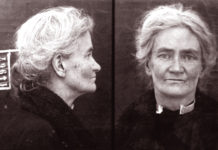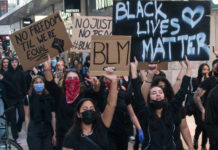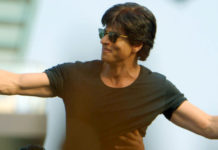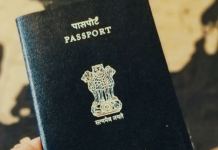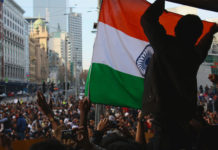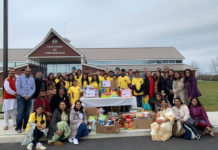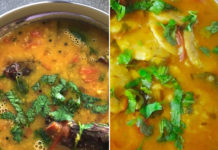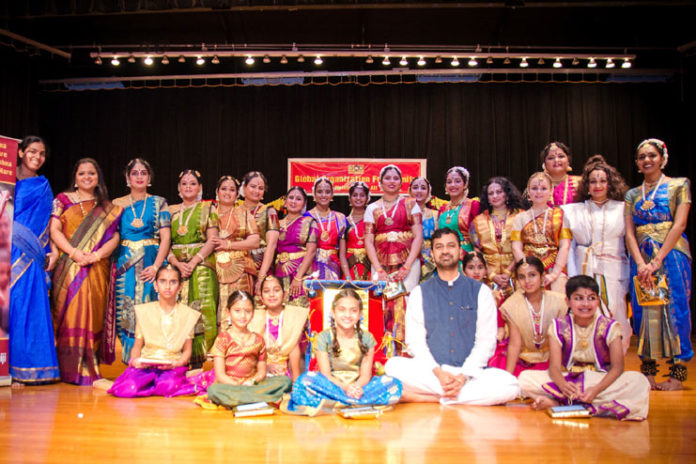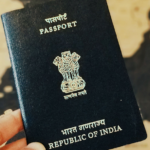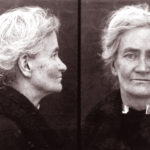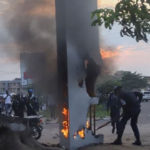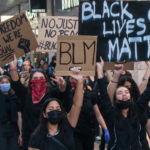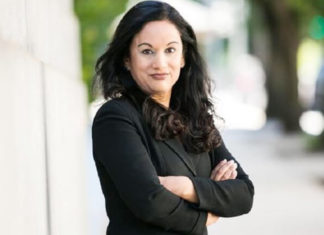Namadwar Houston had presented an exposition of exquisite music combined with exclusive Bharatanatyam dance “Bhakti Sugandham” which is otherwise known as Devotional Fragrance. It was depicted as “Navadha Bhakti” comprises in nine ways of connecting with God. The dance performance was embodied with expressions of nine different emotions called “Nava Rasa” and the Global Organizations of Divinity that produced the program with the music compositions done by His Holiness Sri Sri Muralidhara Swamiji.
To inculcate the nine different forms of Rasa or emotion many episodes from Srimad Bhagavatham were taken and woven into expressive performance through narrative Bharatanatyam. The concept of “Bhakti Sugandham” being sublime, extra efforts were put by the dance choreographer Surabhi Veeraraghavan and exclusive music rendition of Uma Ranganathan. Both the Artistic directors had spent a whole year of planning and preparations with creativity and production of phenomenal orchestra accompaniments and costumes.
Indian American community Chicago to host ICAN awards night
The program began with a video message from HH Sri Sri Muralidhara Swamiji, who had spoke about the purpose and essence of Nama and Namadwaar and the relative merits of listening and chanting the Divine names, as pointed out in Srimad Bhagavatham and conveyed his blessings for the success of the Bhakti Sugandham.
The dance performance began with the Dhyana Sloka, while carrying the Text of Srimad Bhagavatham in a palanquin, as the scripture itself is an embodiment of the deity Lord Krishna Himself. The music was delightfully rendered in Raga Mallari, a classical invocatory Bharatanatyam prelude. This was followed by soulful poetical tribute to Srimad Bhagavatham.
Bhakti Sugandham” dance ballet started with a group dance of swift Jathis portraying the Nava Rasa content of Courage, Disgust, Anger, Compassion, Humor, Fearfulness, Wonder, Love and Peace. Each one of the nine emotions were presented with beautiful “Bhava” or expression by every dancer. The audience had experienced that Rasa Abhinaya was predominant in all of the nine different emotions.
Indian theatre grows rapidly in New England
Veeram or Courage of Bhishma was well depicted by showering arrows on Arjuna nearly killing him when Krishna picked up a wheel and helped Bhishma to keep his vow of either killing Arjuna or forcing Krishna to pick up a weapon.
Bibatsa or disgust was conveyed by the transition of soul passing through the disgusting Vaitrani River as it goes through the cycle of birth and death until redeemed by chanting of the sacred name of God was effectively presented.
The emotion of Anger “Raudram” or Anger was depicted with excellent choreography with fast paced Jathis. It was spun around the Daksha Yagna where Daksha insults his daughter Sati as an uninvited guest and abuses her consort Lord Shiva. She emulates herself in the yogic fire and arouses the anger of Lord Shiva.
The Karunya or Compassion of the Lord Krishna was very touching with the story of a poor childhood friend Sudama while visiting him and was treated with royal welcome by Dwarakadheesh.
Hasyam or humor came out of Samudra manthan, a well-known episode in Hindu Mythology. When Asuras and Devas fought to obtain celestial Nectar “Amrita” by churning the Ocean of Milk. The Devas appealed to Vishnu, who took the form of Mohini as an enchanting damsel, and tricked and distracted the Asuras, took the Amrita, and gave it to the Devas.
Bhayam or Fear was well depicted from the story of the ferocious Narasimha Avatar. The ingenuity of Surabhi Veeraraghavan who had superbly presented Lord Narasimha has done it precisely in Bharatanatyam style. Shobita Arun’s portrayal of the wicked personalities in the scripture were laudable and her Angikabhinaya was awesome. Soujanya Madhusudhan’s presentation was very authentic as she was from the school of training from the branch of the Kalakshetra.
The Adbhutam and Shringaram had episodes of Vamana avatar and Bhakti of Gopis of Vrndhavana respectively. The Gopis dancing with vitrtual dandia was extraordinary and remarkable.
Shantham was shown as the Eternal Peace by taking us to the tranquility of SriVaikunta where Lord Sriman Narayana reposes along with his consort Sri Mahalakshmi.
The other performers were Sandhya Raghuraman, Meenakshi Venkataraman, Divya Koothan, Hema Naren, Jwalanti Prasad, Krishnaya Corbett, Pavithra Chandrasekaran, Radha Venkat, Ratna Ramaraju, Selvi Samy, Shriya Fruitwala, Shruti Natarajan, Usha Prashanth, Varsha Vasu, Zenitha Ram, Advaith Subramanian, Ananya Hariharasudhan, Madhura Sriram, Maithreyi Asthagiri, Maya Shankar and Sahana Thothadri.
The Master of Ceremony Ravi Thottadhri and Malathi Krishnan has put life to the program. Uma Ranganathan melodiously rendered the invocation. Dr. Lekshmi Nair welcomed everyone and gave an introduction about Namadwaar.
She shared the activities of Global Organization of Divinity (G.O.D.) that included enrichment and value classes for the young and youth empowerment, help with Love to Share Foundation and many other outreach programs by holding Health fair and food and clothing drive and meditation classes. She expressed that G.O.D under the direction of their Guru and guidance of Sri Sri Muralidhara Swamigal, the service to Humanity and Divinity are inseparable.
Nisha Giri was an integral part of the production concept and stories that were included. She thanked the Spiritual Guruji of G.O.D. and Sri M.K. Ramanujam Ji, for their blessings and Priya Murale for the idea of the production of Bhakti Sugandham.
It is believed that there are two paths of devotion or Bhakti, which are Shravanam (To hear) and Kirtanam (sing Lord’s Praise). I would add “Natyam” dance as a form of worship as this beautiful dance production of “Bhakti Sugandham” created one such experience, she said.
By Premji


